Increasing consumption of plant-based foods and reducing the consumption of salt and foods of animal origin lowers risk of heart disease. The quantity and frequency of consumption matters in reducing the risk of the disease.
- Increasing consumption of plant-based foods and reducing the consumption of salt and foods of animal origin lowers risk of atherosclerosis
- The quantity of food and frequency of consumption matters in reducing the risk of heart disease
Overall, there is consistent evidence that for healthy adults, low consumption of salt and foods of animal origin, and increased intake of plant-based foods - including whole grains, fruits, vegetables, legumes and nuts - are linked with reduced risk of atherosclerosis.
The same applies to replacing butter and other animal fats with non-tropical vegetable fats such as olive oil.
New evidence differentiates processed and red meat - both associated with increased risk of cardiovascular disease - from poultry, which shows no relationship at moderate intakes (up to three servings of 100 g per week).
Red meat (i.e. beef, pork, lamb) should be limited to two servings of 100 g per week, and processed meat (i.e. bacon, sausages, salami) limited to occasional use.
Moderate fish consumption (two to four servings of 150 g per week) is also supported by the latest evidence for prevention of heart disease, although there might be sustainability concerns. Poultry may be a suitable protein alternative to red meat, but in moderate amounts.
For the healthy population, recent evidence does not support a requirement to use low-fat, instead of full-fat, dairy products to prevent heart disease. Rather, both full-fat and low-fat dairy products, in moderate amounts and in the context of a balanced diet, are not associated with increased risk.
"Small quantities of cheese (three servings of 50 g per week) and regular yogurt consumption (200 g per day) are even linked with a protective effect due to the fact that they are fermented," said Professor Riccardi. "We now understand that gut bacteria play a major role in influencing cardiovascular risk. Fermented dairy products contain good bacteria which promote health."
With respect to cereals, novel advice is given according to the glycaemic index (GI), where high GI foods raise blood sugar more quickly than low GI foods.
High GI foods (i.e. white bread, white rice) are associated with an elevated atherosclerosis risk; therefore, consumption should be limited to two servings per week and they should otherwise be replaced with whole grain foods (i.e. bread, rice, oat, barley) and low GI foods (i.e. pasta, parboiled rice, corn tortilla).
As for beverages, coffee and tea (up to three cups daily) are associated with reduced cardiovascular risk. Soft drinks, including low-calorie options, are linked with higher risk and should be replaced with water except on limited occasions.
Moderate alcohol consumption (wine: up to two glasses per day in men and one glass in women; or one can of beer) is associated with a lower risk of heart disease compared to higher amounts or abstinence.
But Professor Riccardi said: "Considering the overall impact of alcohol on health, this evidence should be interpreted as the maximal allowed intake rather than a recommended amount."
Regarding chocolate, the available evidence allows up to 10 g of dark chocolate per day. The authors state that "for this amount of consumption the beneficial effects exceed the risk of weight gain and its related harmful consequences on cardiovascular health".
Professor Riccardi noted that eating should be enjoyable to motivate healthy people to make long-term changes. He said: "We need to rediscover culinary traditions such as the Mediterranean diet which has delicious recipes using beans, whole grains, nuts, fruits and vegetables."
The authors concluded:"A strategy based exclusively on guidelines and nutritional education will not be sufficient to change the lifestyle of the population; policy options to be considered should necessarily include initiatives to facilitate production, marketing, availability and affordability of foods that are not only healthy but also gastronomically appealing."
Source-Eurekalert
















